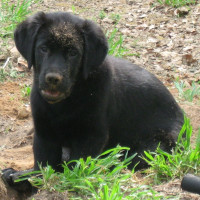Appearance of the New Labralound
|
| The New Labralound is a gentle giant with curious little brown eyes and a leathery black nose on a large, tapering muzzle. They have floppy, furry ears, a large forehead, long, strong legs and a long, feathered tail that hangs down unless he wags, which he often does. Their coat is very dense and water-resistant, can be straight or slightly wavy, medium to long in length, but is always soft and fluffy. Some of the most common colors of this breed are black and white, black, brown and white, brown, cream, fawn and brown, fawn and white, fawn, brindle, sable, and piebald. |
Temperament of the New Labralound
|
| The New Labralound is one of the friendliest dog breeds around, due to its parentage. They are known as one of the best family dogs because they are gentle and affectionate with children and other pets, show little or no aggression and are easy to train. However, you'll need to keep them on a leash when outside if your dog isn't in a fenced-in area, as they'll chase squirrels, rabbits and other wildlife. They love to play with other dogs, so there shouldn't be any problems at the dog park or anywhere else you might see other dogs. |
Needs and activities of the New Labralound
|
| New Labralounds need plenty of activity to stay healthy and happy. They tend to become obese if they don't get enough exercise. It's best for your New Labralound to get at least an hour to an hour and a half of vigorous exercise a day. They're happy to be outdoors and love to hunt local wildlife, so if you're going to the park, be prepared for that. They love swimming, agility training, hiking, long walks, running, playing ball and any other activity that gets them out and about. If they don't get enough exercise, they can develop behavioral problems like barking and chewing things. |
Maintenance of the New Labralound
|
| Your New Labralound should be brushed at least five or six times a week with a pin brush and a metal comb. You should also use a detangling tool during the molting season, as they tend to shed a lot of hair at this time. To keep their ears clean, wipe them with a damp cotton ball every week and also check for mites, earwax, redness or irritation. Their nails should be trimmed when necessary, which is usually about once a month. In addition, you should brush your dog's teeth with a soft toothbrush and toothpaste specially designed for dogs. This will help prevent cavities and other dental problems. |









 English (United Kingdom)
English (United Kingdom)